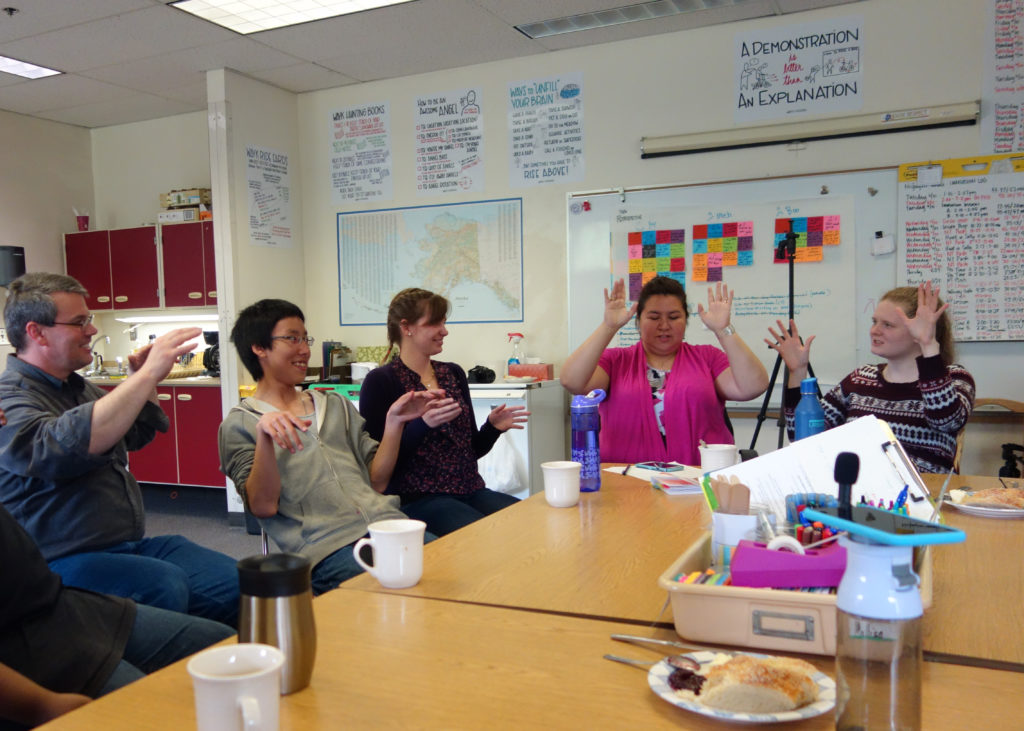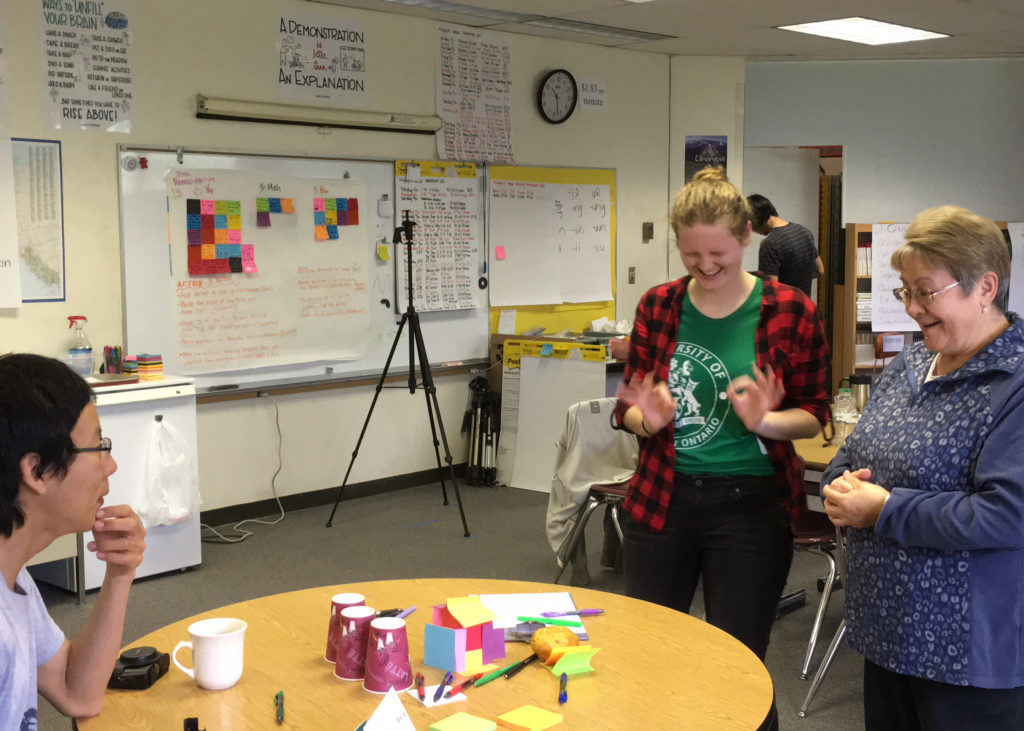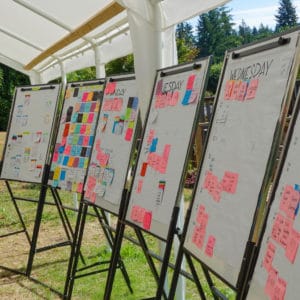
Learning another language is tough—new sounds that our mouths are not used to pronouncing, unfamiliar words, and grammar structures that just don’t feel normal. It is completely natural to want an explanation or a translation for all the new concepts and patterns in our first language. Just tell me what it means! If the word is explained, one might reason, then I’ll learn it faster and be able to speak better, right? Well, it may come as a surprise to some that the WAYK method actually encourages you to avoid giving a translation as often as possible—it is a Technique called “Spare the Fairies.”
The idea is that each language has unique ways of conceptualizing and describing things. If we immediately translate into our dominant language, what we are, in effect, doing, is equating one language with another. While this may help understanding in the short term, in the long run it can actually trick someone into thinking that they understand something when in fact they do not. In a similar way to that idea that a joke is no longer funny if you have to explain it, some concepts lose the depth of their meaning if they are translated. But even more than that, there are some ideas that really don’t make sense unless they are kept within the context of that language. Unfortunately, this is a concept that can be hard to understand if you do not know a second language yourself. So, here are a few examples to illustrate what I mean:
- In Mandarin, the word “是” (shi) is sometimes translated to mean “yes.” And, yes, if someone were to respond to the question “Is that a cup?” with “shi,” a fairly accurate English translation would be that they had responded with “yes.” But this is only an illusion of understanding. In actuality, Mandarin doesn’t have a single word for yes or no, but rather a system for communicating the idea of ‘yes’ or ‘no’ using verbs. A more accurate way of explaining “shi” is that it is actually the verb “to be.” You could actually express similar ideas of ‘yes’ or ‘no’ using almost any verb, like ‘want’, ‘drink’ or ‘eat’. That is an example of structural difference between English and Chinese. Both deal with giving an affirmative or negative in different, yet fascinating ways, but just saying that “shi” means “yes” creates the illusion that they are the same word with just different sounds. They are not.
- Here is another example, also from Mandarin. The Mandarin word for “connection” is “关系” (guanxi). You could use it to ask what connection one event has to another, or what relation a person has to another. However, just stopping here misses, or maybe dismisses, the fact that guanxi actually contains a whole understanding of social standing, value and social obligation between people that permeates and affects Chinese culture in so many ways. In fact, this word has such a deep meaning and significance, I have only barely scratched the surface. I ‘know’ the word, but do I fully understand what is being communicated when it is used? Perhaps not.
- What about from English? How would one explain the word for “clean”? Not dirty perhaps. But it is also a verb implying the act of removing dirt. But then what about when someone uses “clean language”? Language cannot carry dirt, it has no substance, but that is one way that English describes language use that is perhaps not appropriate. What about “shed”? Or “up” or “run”? All concepts that might seem easy to explain with a simple translation but which, after a little thought, become much more complicated. Killing fairies through direct translation simplifies things in ways that they may not actually be.
The irony of giving these example here is that I have actually just killed fairies in a blog about not killing fairies. But for anyone who only speaks one language, this might be the best way to illustrate the idea. The fact that it’s hard for me to easily explain the true meaning of these words is evidence in itself that any kind of direct translation is inadequate. These examples leave out lots of other ways the words can be used, or layers of meaning that each concept contains. As a learner of Mandarin, I am still discovering new ways that those two concepts (“是” and “关系” ) work and perhaps I will always be discovering new things about them.
The idea that you can use one language to fully understand another is like thinking that you know someone just because you know their sibling. You may know things about the person, and you there may be similarities between the siblings but you cannot truly say you know someone unless you let them step out of their sibling’s shadow and let them speak for themselves. In my mind, English and even Chinese feel like big brothers to Niiĝuĝim Tunuu. Together they may help me understand aspects of this new language, but ultimately I need to learn about Niiĝuĝim Tunuu on its own terms, from the speakers and community that use it.

Well, now I have given a lengthy explanation for why we shouldn’t kill the metaphorical language fairies, it’s time to talk about how, practically speaking, TQ: Spare the Fairies actually works. The TQ is used in a lot of ways, but it isn’t always visible like other techniques might be. To actually throw the technique sign, we need to catch someone just as they are about to explain or translate an idea and warn them to stop. The point that instead of relying on translations to learn, we are telling our dominant language to take a backseat. We are trying to learn conceptually from demonstrations rather than forcing a connection and equivalency between words from another language where a connection needn’t be. This allows the language to speak for itself, to reveal its nuances, without another language getting involved and imposing itself.
In a way, Spare the Fairies is actually supported by all the WAYK techniques (and supports them in turn), simply because they all work together to maintain immersion in the language. Talking about, analyzing and translating ideas from a language does have a time and place when it is helpful (when creating a dictionary, for example). However, when you are trying to learn a language, the more time you spend talking about a language, the less time you actually spend thinking in the language and using the language. If you learn the language in the context of a Set Up, you are learning while engaging your “target language brain” rather than through the lens of your “English brain” (or whatever your dominant language may be).
And while it can take longer to understand something when you have to rely on someone setting up a physical representation to demonstrate a new word or concept, I find I prefer learning languages this way because, ultimately, it is so much more satisfying when I am finally able to say “I got it” after a long time of wrestling with the mystery word or concept. Besides, learning the word for ‘tripping’ after actually falling on your face and embarrassing yourself is a much more memorable way to learn than reading it in a dictionary.
Oh, and since I did kill some fairies in this post, it’s time I right this heinous wrong! I do believe in fairies, I do believe in fairies, I do believe in fairies! (TQ: I Do Believe in Fairies)
Post authored by Erin.




